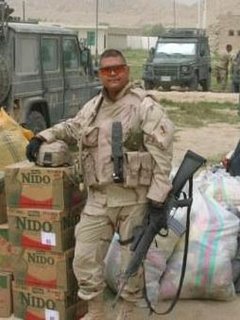Dining at the Mess
On BAF, there is a wonderful little Korean restaurant. It has bulgogi, kimchee, gim-bahp (Korean for sushi), fried rice, and a whole bunch of other things. It is run by the company that manages the Korean dining facility and they are doing quite well. You have to go in hungry; $8 purchases a phenomenal amount of food. The food is as good as or better than any Korean restaurant stateside.
The Canadian PRT in Kandahar City has a mess (what they call a dining facility) run by Canadian Army personnel. The PRT at Tarin Kowt, where I was at for six months, was run by US Army personnel. The food at the Canadian PRT is far better than the food at the Tarin Kowt PRT. One reason for the difference in quality is the ingredients. The food for the Canadian PRT comes in on a plane and is at the PRT in less than a day (plane lands, unload plane, inspect pallets, load trucks, drive 20 minutes to PRT). The other reason for the quality is that the Canadian Army cooks are really good.
The food for the PRT at Tarin Kowt and all the little FOB’s (forward operating bases) in the region consist of what we old timers call “A” rations, or what are now called UGR-A’s (Unitized Group Ration-A). UGR-A’s come in a combination of canned, frozen, and shelf stable foodstuffs in three boxes. The stuff is nourishing but gets old after awhile. We had one cook who was from the Texas National Guard and that man can work wonders with the UGR-A’s because he cared and had an artistic touch. The remaining cooks followed the instructions and that was that.
The British Army set up their own mess (they rightly refuse to call it a DFAC) last month. The rumors that floated around that it was quite good. For those of you who have traveled in the United Kingdom, I bet money that you didn’t visit for the food. My bride spent a semester attending the University of Glasgow and the cafeteria would serve potatoes three different ways.
I was invited to a working dinner with my coalition colleagues at the British mess today and I jumped at the chance. The place is managed by mess sergeants and the workers are from Sri Lanka. The food was FANTASTIC!! Lamb chops with a hint of mint, sweet and sour chicken breast, curried pork, beef pot pie, steak with onions and mushrooms, assorted vegetables, bread pudding, assorted cakes and tarts, brie and crackers, and more.
I couldn’t believe I was in a military dining facility until I was politely asked by a mess sergeant if I was a regular patron when I went back for seconds. Non British service members eat there by invitation only. I pointed to my group and said I was with them to which he responded with “very good sir, enjoy your meal” to which I responded “I will, thank you and might I add that you all have done a superb job!”
KBR and the US Army can learn a thing or two from our British brethren. Dining at the mess is so much more preferable than chow at the DFAC.
CIAO’
CPT NightHawk

